Legal Workplace Report: Roles, Dispute Resolution in Australian Courts
VerifiedAdded on 2022/08/31
|7
|1219
|19
Report
AI Summary
This report provides an overview of the legal workplace, detailing the roles and responsibilities of lawyers, including client confidentiality, avoiding conflicts of interest, and maintaining diligence. It also outlines the functions of paralegals and other professionals in the legal system, such as conducting client interviews and assisting with case management. The report further explores various dispute resolution processes in Australia, including negotiation, mediation, and arbitration. Additionally, it examines the structure and role of the Federal Circuit Court, detailing its jurisdiction over family and general law matters. The report includes interview excerpts with a paralegal and a law clerk, shedding light on their specific tasks and contributions within a law firm. Finally, the report references key academic sources to support its findings.
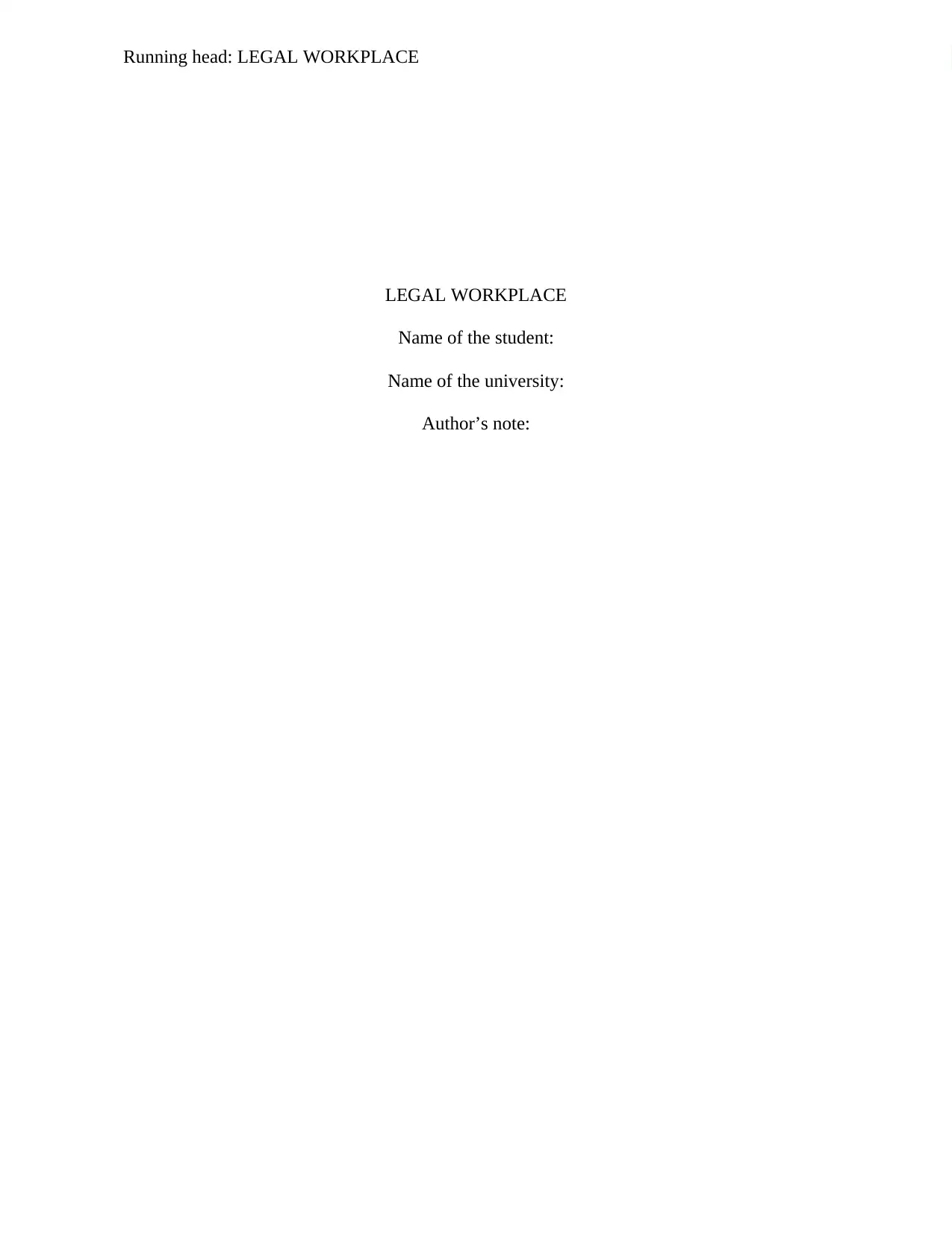
Running head: LEGAL WORKPLACE
0
LEGAL WORKPLACE
Name of the student:
Name of the university:
Author’s note:
0
LEGAL WORKPLACE
Name of the student:
Name of the university:
Author’s note:
Paraphrase This Document
Need a fresh take? Get an instant paraphrase of this document with our AI Paraphraser
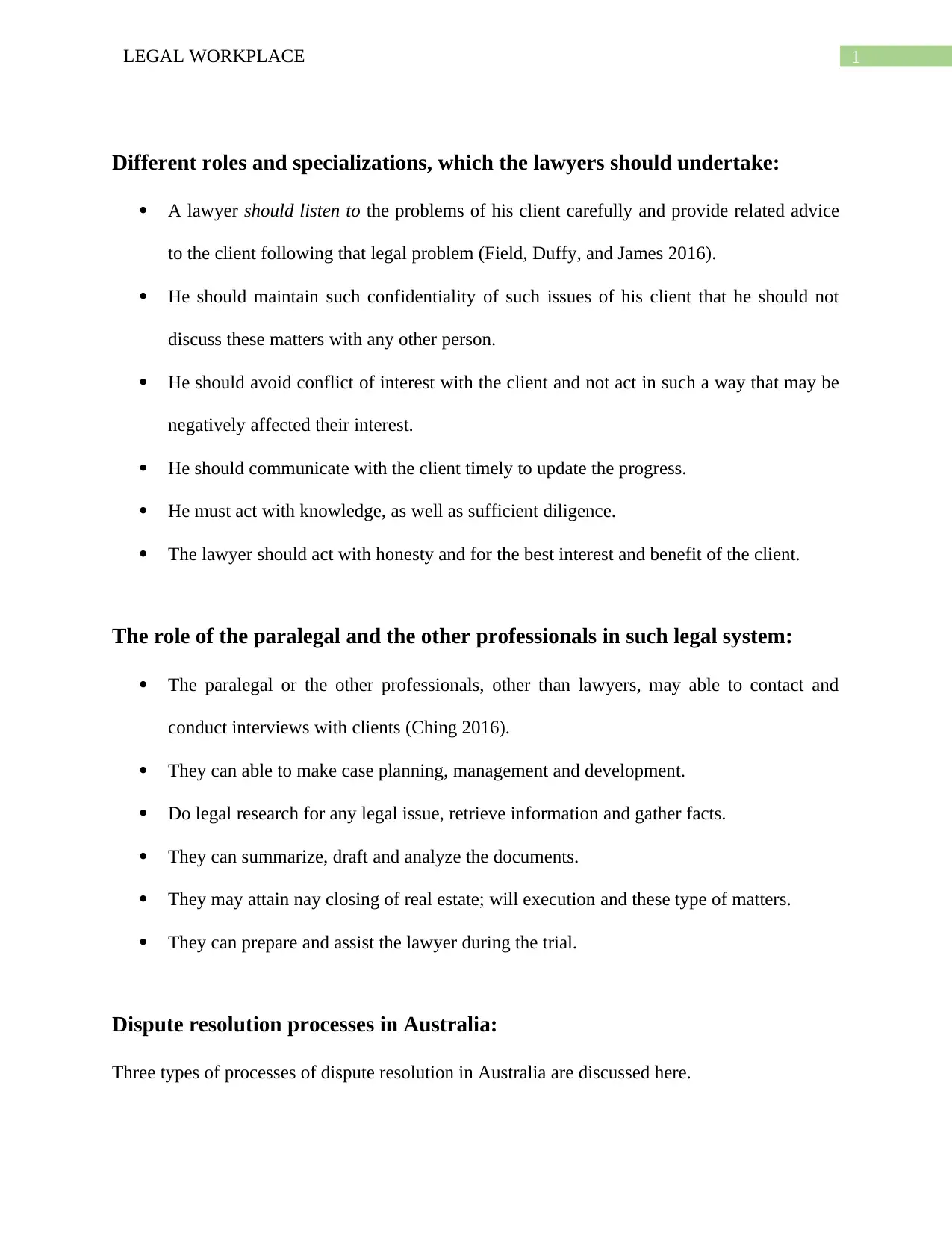
1LEGAL WORKPLACE
Different roles and specializations, which the lawyers should undertake:
A lawyer should listen to the problems of his client carefully and provide related advice
to the client following that legal problem (Field, Duffy, and James 2016).
He should maintain such confidentiality of such issues of his client that he should not
discuss these matters with any other person.
He should avoid conflict of interest with the client and not act in such a way that may be
negatively affected their interest.
He should communicate with the client timely to update the progress.
He must act with knowledge, as well as sufficient diligence.
The lawyer should act with honesty and for the best interest and benefit of the client.
The role of the paralegal and the other professionals in such legal system:
The paralegal or the other professionals, other than lawyers, may able to contact and
conduct interviews with clients (Ching 2016).
They can able to make case planning, management and development.
Do legal research for any legal issue, retrieve information and gather facts.
They can summarize, draft and analyze the documents.
They may attain nay closing of real estate; will execution and these type of matters.
They can prepare and assist the lawyer during the trial.
Dispute resolution processes in Australia:
Three types of processes of dispute resolution in Australia are discussed here.
Different roles and specializations, which the lawyers should undertake:
A lawyer should listen to the problems of his client carefully and provide related advice
to the client following that legal problem (Field, Duffy, and James 2016).
He should maintain such confidentiality of such issues of his client that he should not
discuss these matters with any other person.
He should avoid conflict of interest with the client and not act in such a way that may be
negatively affected their interest.
He should communicate with the client timely to update the progress.
He must act with knowledge, as well as sufficient diligence.
The lawyer should act with honesty and for the best interest and benefit of the client.
The role of the paralegal and the other professionals in such legal system:
The paralegal or the other professionals, other than lawyers, may able to contact and
conduct interviews with clients (Ching 2016).
They can able to make case planning, management and development.
Do legal research for any legal issue, retrieve information and gather facts.
They can summarize, draft and analyze the documents.
They may attain nay closing of real estate; will execution and these type of matters.
They can prepare and assist the lawyer during the trial.
Dispute resolution processes in Australia:
Three types of processes of dispute resolution in Australia are discussed here.
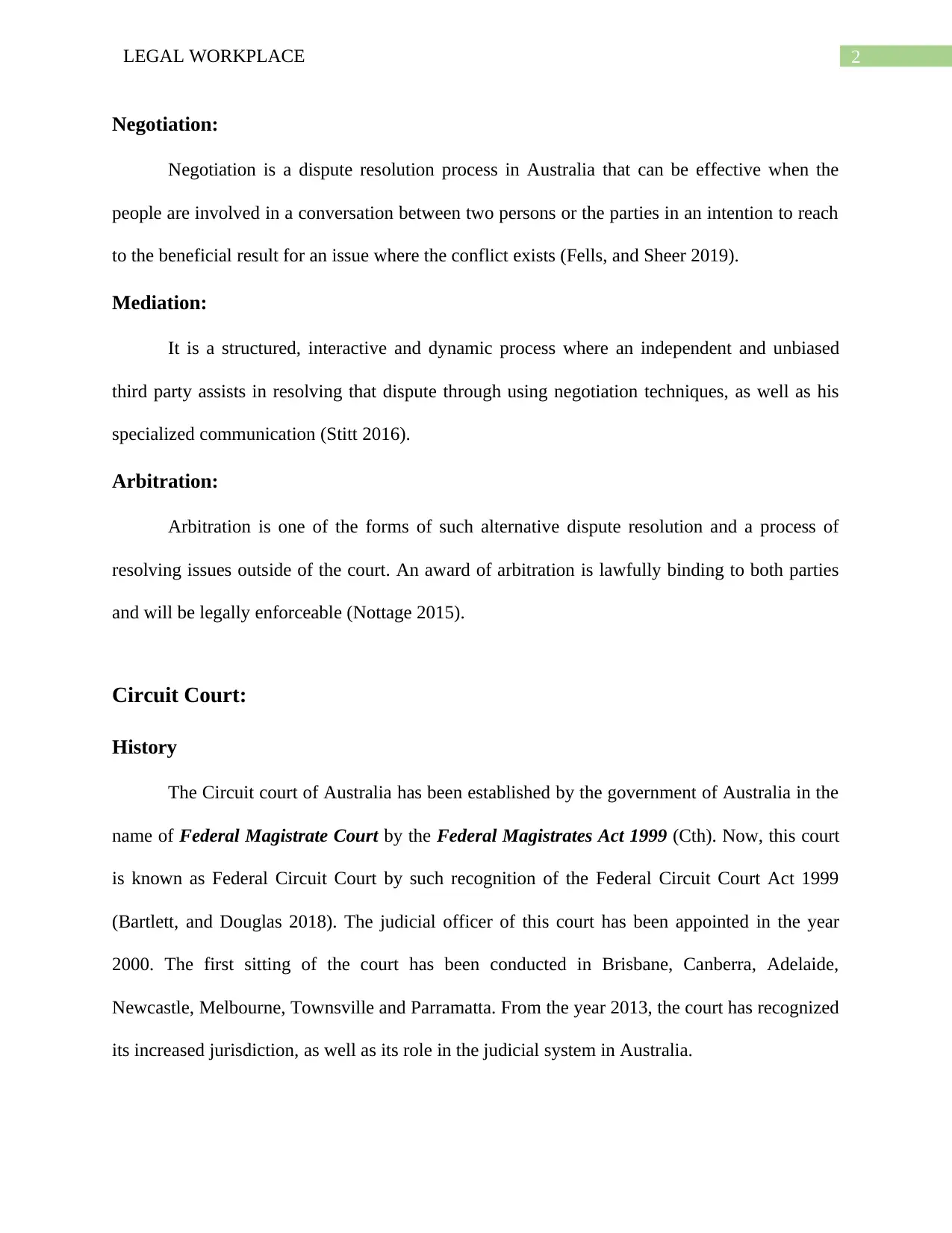
2LEGAL WORKPLACE
Negotiation:
Negotiation is a dispute resolution process in Australia that can be effective when the
people are involved in a conversation between two persons or the parties in an intention to reach
to the beneficial result for an issue where the conflict exists (Fells, and Sheer 2019).
Mediation:
It is a structured, interactive and dynamic process where an independent and unbiased
third party assists in resolving that dispute through using negotiation techniques, as well as his
specialized communication (Stitt 2016).
Arbitration:
Arbitration is one of the forms of such alternative dispute resolution and a process of
resolving issues outside of the court. An award of arbitration is lawfully binding to both parties
and will be legally enforceable (Nottage 2015).
Circuit Court:
History
The Circuit court of Australia has been established by the government of Australia in the
name of Federal Magistrate Court by the Federal Magistrates Act 1999 (Cth). Now, this court
is known as Federal Circuit Court by such recognition of the Federal Circuit Court Act 1999
(Bartlett, and Douglas 2018). The judicial officer of this court has been appointed in the year
2000. The first sitting of the court has been conducted in Brisbane, Canberra, Adelaide,
Newcastle, Melbourne, Townsville and Parramatta. From the year 2013, the court has recognized
its increased jurisdiction, as well as its role in the judicial system in Australia.
Negotiation:
Negotiation is a dispute resolution process in Australia that can be effective when the
people are involved in a conversation between two persons or the parties in an intention to reach
to the beneficial result for an issue where the conflict exists (Fells, and Sheer 2019).
Mediation:
It is a structured, interactive and dynamic process where an independent and unbiased
third party assists in resolving that dispute through using negotiation techniques, as well as his
specialized communication (Stitt 2016).
Arbitration:
Arbitration is one of the forms of such alternative dispute resolution and a process of
resolving issues outside of the court. An award of arbitration is lawfully binding to both parties
and will be legally enforceable (Nottage 2015).
Circuit Court:
History
The Circuit court of Australia has been established by the government of Australia in the
name of Federal Magistrate Court by the Federal Magistrates Act 1999 (Cth). Now, this court
is known as Federal Circuit Court by such recognition of the Federal Circuit Court Act 1999
(Bartlett, and Douglas 2018). The judicial officer of this court has been appointed in the year
2000. The first sitting of the court has been conducted in Brisbane, Canberra, Adelaide,
Newcastle, Melbourne, Townsville and Parramatta. From the year 2013, the court has recognized
its increased jurisdiction, as well as its role in the judicial system in Australia.
⊘ This is a preview!⊘
Do you want full access?
Subscribe today to unlock all pages.

Trusted by 1+ million students worldwide
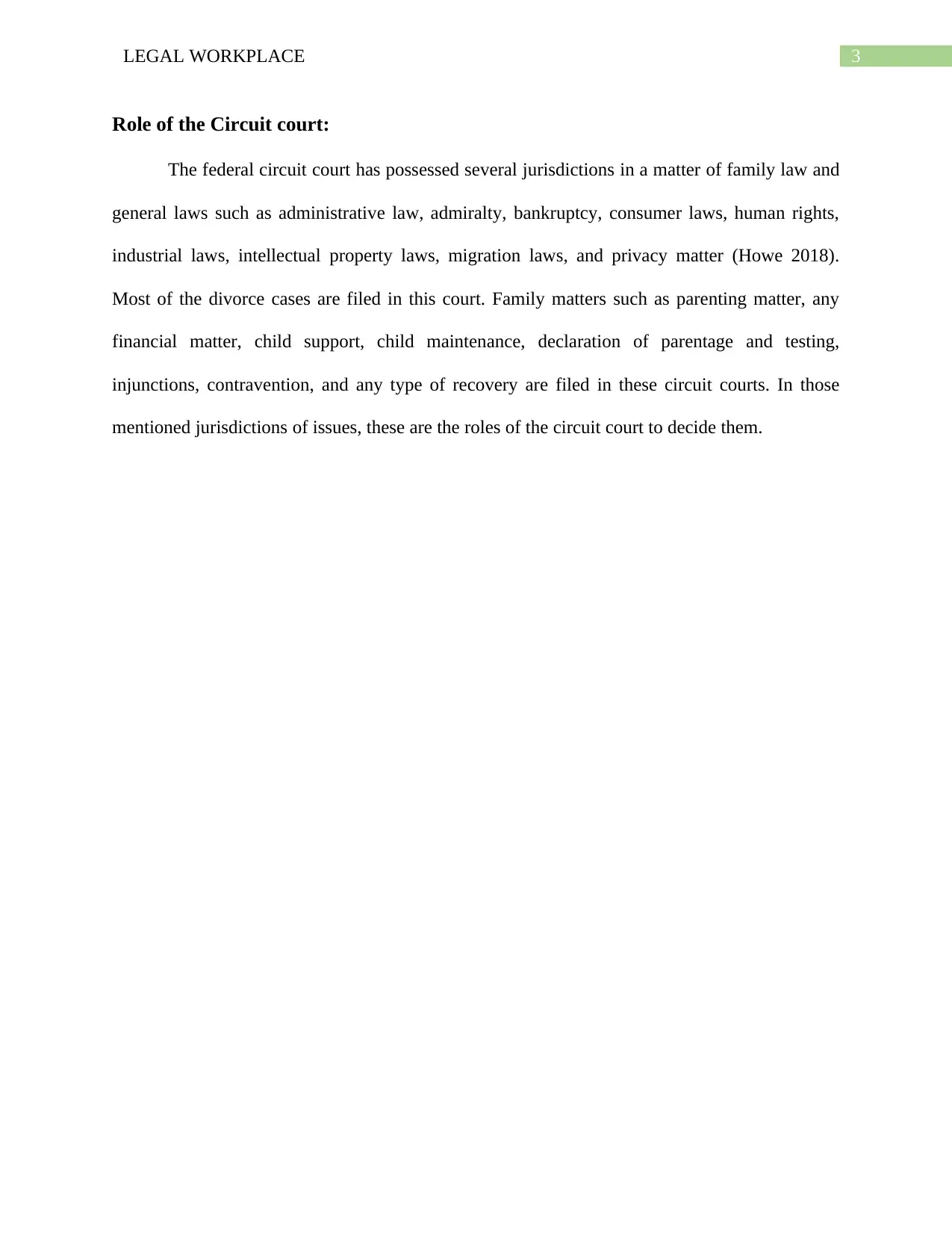
3LEGAL WORKPLACE
Role of the Circuit court:
The federal circuit court has possessed several jurisdictions in a matter of family law and
general laws such as administrative law, admiralty, bankruptcy, consumer laws, human rights,
industrial laws, intellectual property laws, migration laws, and privacy matter (Howe 2018).
Most of the divorce cases are filed in this court. Family matters such as parenting matter, any
financial matter, child support, child maintenance, declaration of parentage and testing,
injunctions, contravention, and any type of recovery are filed in these circuit courts. In those
mentioned jurisdictions of issues, these are the roles of the circuit court to decide them.
Role of the Circuit court:
The federal circuit court has possessed several jurisdictions in a matter of family law and
general laws such as administrative law, admiralty, bankruptcy, consumer laws, human rights,
industrial laws, intellectual property laws, migration laws, and privacy matter (Howe 2018).
Most of the divorce cases are filed in this court. Family matters such as parenting matter, any
financial matter, child support, child maintenance, declaration of parentage and testing,
injunctions, contravention, and any type of recovery are filed in these circuit courts. In those
mentioned jurisdictions of issues, these are the roles of the circuit court to decide them.
Paraphrase This Document
Need a fresh take? Get an instant paraphrase of this document with our AI Paraphraser
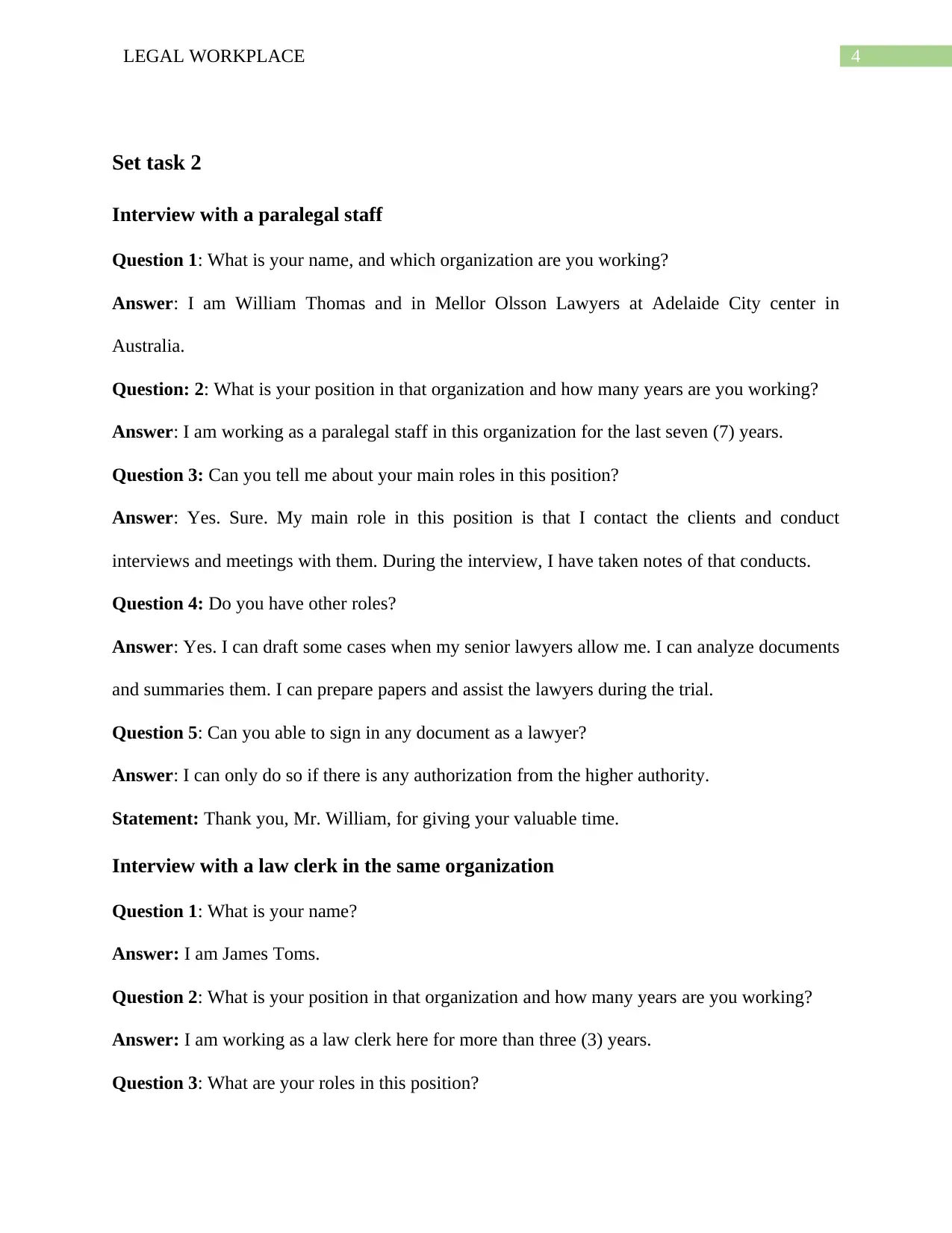
4LEGAL WORKPLACE
Set task 2
Interview with a paralegal staff
Question 1: What is your name, and which organization are you working?
Answer: I am William Thomas and in Mellor Olsson Lawyers at Adelaide City center in
Australia.
Question: 2: What is your position in that organization and how many years are you working?
Answer: I am working as a paralegal staff in this organization for the last seven (7) years.
Question 3: Can you tell me about your main roles in this position?
Answer: Yes. Sure. My main role in this position is that I contact the clients and conduct
interviews and meetings with them. During the interview, I have taken notes of that conducts.
Question 4: Do you have other roles?
Answer: Yes. I can draft some cases when my senior lawyers allow me. I can analyze documents
and summaries them. I can prepare papers and assist the lawyers during the trial.
Question 5: Can you able to sign in any document as a lawyer?
Answer: I can only do so if there is any authorization from the higher authority.
Statement: Thank you, Mr. William, for giving your valuable time.
Interview with a law clerk in the same organization
Question 1: What is your name?
Answer: I am James Toms.
Question 2: What is your position in that organization and how many years are you working?
Answer: I am working as a law clerk here for more than three (3) years.
Question 3: What are your roles in this position?
Set task 2
Interview with a paralegal staff
Question 1: What is your name, and which organization are you working?
Answer: I am William Thomas and in Mellor Olsson Lawyers at Adelaide City center in
Australia.
Question: 2: What is your position in that organization and how many years are you working?
Answer: I am working as a paralegal staff in this organization for the last seven (7) years.
Question 3: Can you tell me about your main roles in this position?
Answer: Yes. Sure. My main role in this position is that I contact the clients and conduct
interviews and meetings with them. During the interview, I have taken notes of that conducts.
Question 4: Do you have other roles?
Answer: Yes. I can draft some cases when my senior lawyers allow me. I can analyze documents
and summaries them. I can prepare papers and assist the lawyers during the trial.
Question 5: Can you able to sign in any document as a lawyer?
Answer: I can only do so if there is any authorization from the higher authority.
Statement: Thank you, Mr. William, for giving your valuable time.
Interview with a law clerk in the same organization
Question 1: What is your name?
Answer: I am James Toms.
Question 2: What is your position in that organization and how many years are you working?
Answer: I am working as a law clerk here for more than three (3) years.
Question 3: What are your roles in this position?

5LEGAL WORKPLACE
Answer: I can conduct interviews with clients like Mr. William. I also research on legal theories
for the help of our seniors. I can prepare bench memos, draft opinion and orders of our seniors. I
have to proofread the opinions and orders of the judges for any related case.
Statement: Thank you Mr. James.
Answer: I can conduct interviews with clients like Mr. William. I also research on legal theories
for the help of our seniors. I can prepare bench memos, draft opinion and orders of our seniors. I
have to proofread the opinions and orders of the judges for any related case.
Statement: Thank you Mr. James.
⊘ This is a preview!⊘
Do you want full access?
Subscribe today to unlock all pages.

Trusted by 1+ million students worldwide
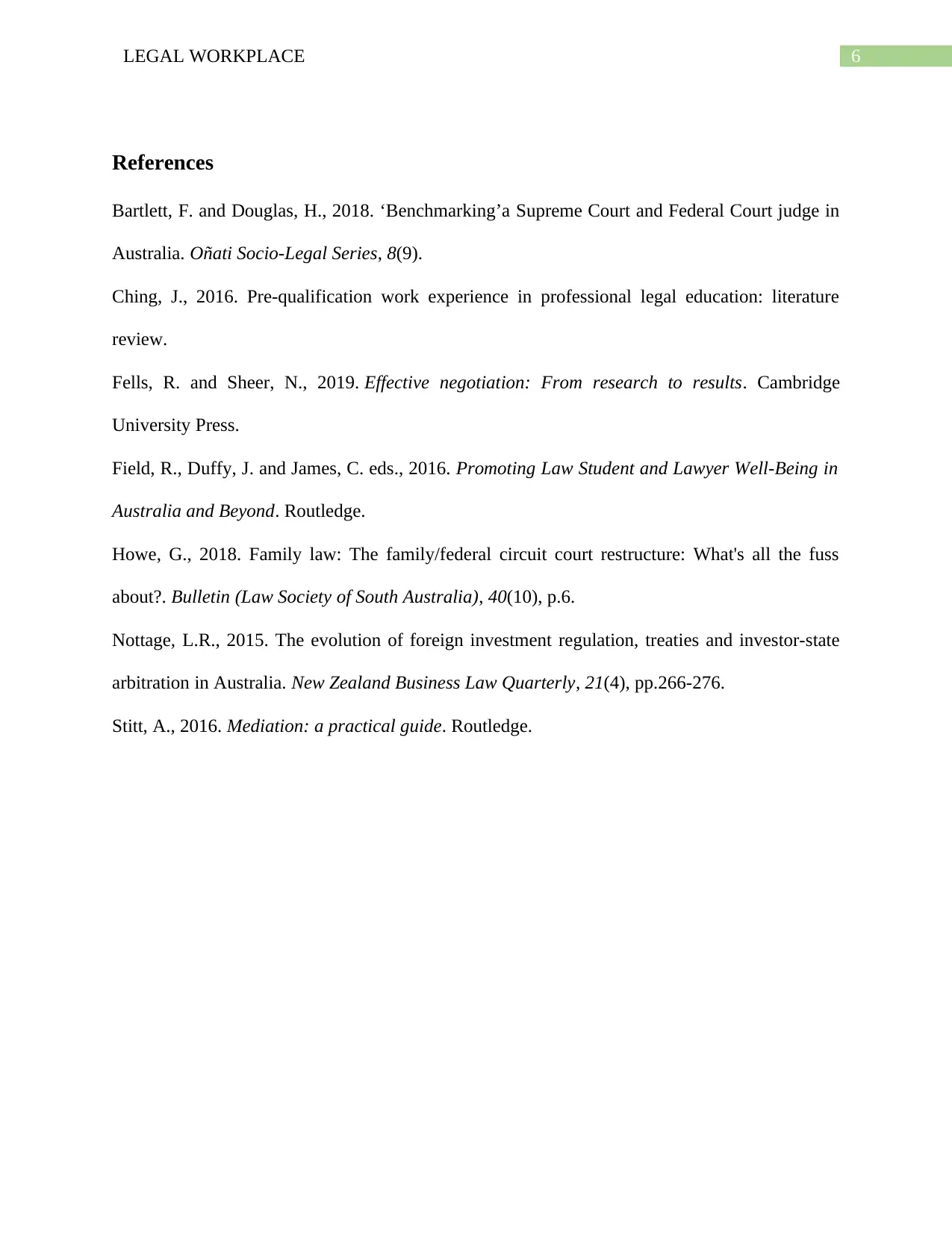
6LEGAL WORKPLACE
References
Bartlett, F. and Douglas, H., 2018. ‘Benchmarking’a Supreme Court and Federal Court judge in
Australia. Oñati Socio-Legal Series, 8(9).
Ching, J., 2016. Pre-qualification work experience in professional legal education: literature
review.
Fells, R. and Sheer, N., 2019. Effective negotiation: From research to results. Cambridge
University Press.
Field, R., Duffy, J. and James, C. eds., 2016. Promoting Law Student and Lawyer Well-Being in
Australia and Beyond. Routledge.
Howe, G., 2018. Family law: The family/federal circuit court restructure: What's all the fuss
about?. Bulletin (Law Society of South Australia), 40(10), p.6.
Nottage, L.R., 2015. The evolution of foreign investment regulation, treaties and investor-state
arbitration in Australia. New Zealand Business Law Quarterly, 21(4), pp.266-276.
Stitt, A., 2016. Mediation: a practical guide. Routledge.
References
Bartlett, F. and Douglas, H., 2018. ‘Benchmarking’a Supreme Court and Federal Court judge in
Australia. Oñati Socio-Legal Series, 8(9).
Ching, J., 2016. Pre-qualification work experience in professional legal education: literature
review.
Fells, R. and Sheer, N., 2019. Effective negotiation: From research to results. Cambridge
University Press.
Field, R., Duffy, J. and James, C. eds., 2016. Promoting Law Student and Lawyer Well-Being in
Australia and Beyond. Routledge.
Howe, G., 2018. Family law: The family/federal circuit court restructure: What's all the fuss
about?. Bulletin (Law Society of South Australia), 40(10), p.6.
Nottage, L.R., 2015. The evolution of foreign investment regulation, treaties and investor-state
arbitration in Australia. New Zealand Business Law Quarterly, 21(4), pp.266-276.
Stitt, A., 2016. Mediation: a practical guide. Routledge.
1 out of 7
Related Documents
Your All-in-One AI-Powered Toolkit for Academic Success.
+13062052269
info@desklib.com
Available 24*7 on WhatsApp / Email
![[object Object]](/_next/static/media/star-bottom.7253800d.svg)
Unlock your academic potential
Copyright © 2020–2025 A2Z Services. All Rights Reserved. Developed and managed by ZUCOL.





